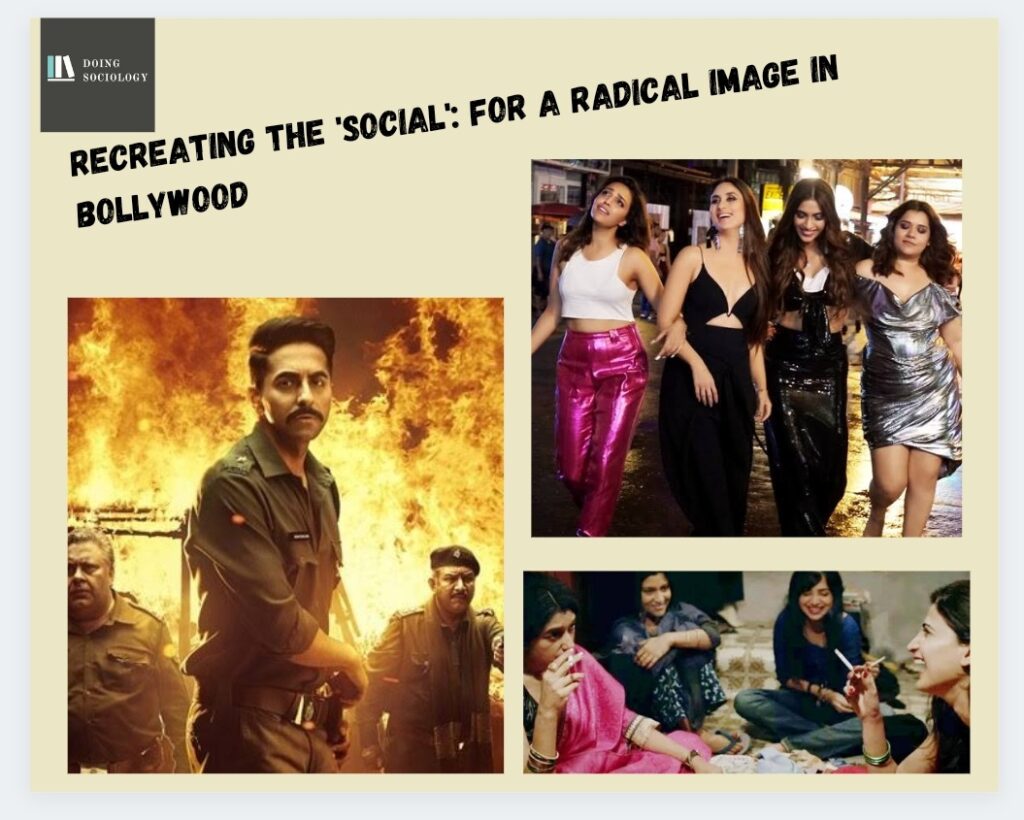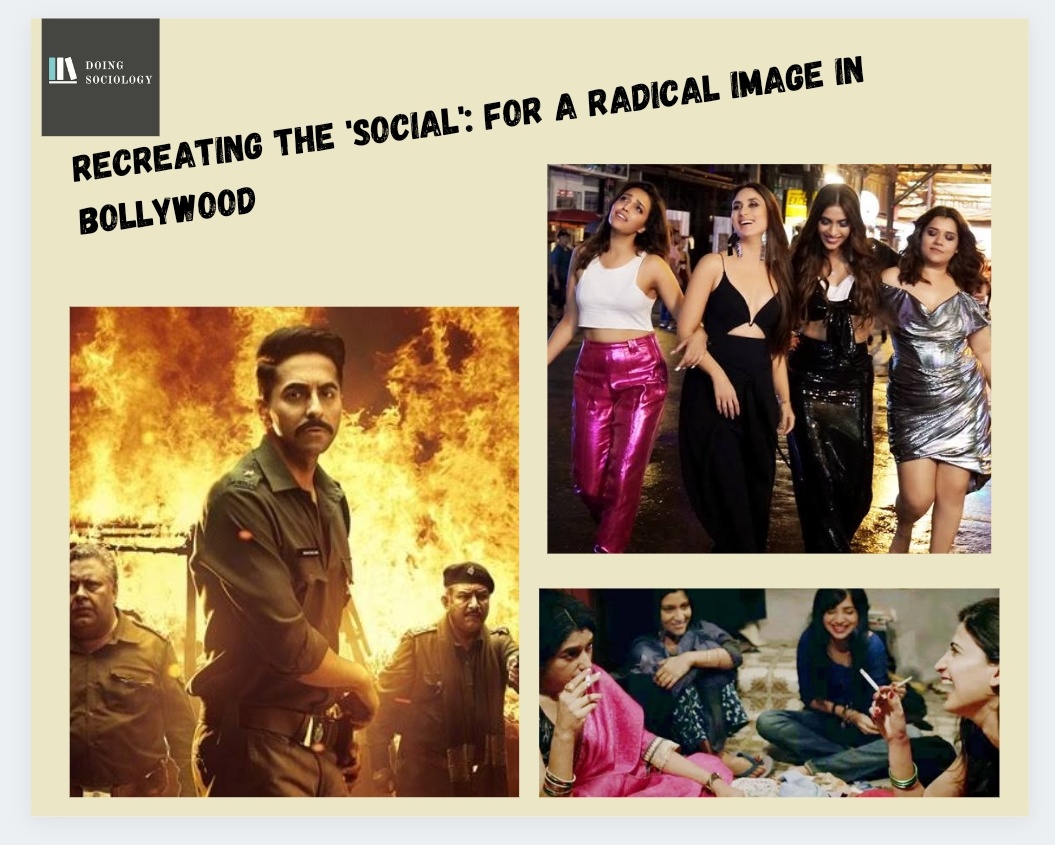
I grew up watching commercial Bollywood films[i]. Though now I am more exposed to cinema from across the world, I still feel at home with Bollywood films. When I did my Masters in sociology in a town of South Karnataka, I had several batch mates and teachers who hailed from Kerala and Tamil Nadu. I got to be more familiar with new age Tamil and Malayalam films, which I felt had ‘something’ which Bollywood does not. Since then, I have been thinking about what that ‘something’ is. I wish to express this sociologically in this essay.
Important commercial Bollywood films in the recent past that gained attention in media for being ‘radical’ with portrayals of gender, sexuality and caste, are Lipstick Under My Burkha (LUMB, 2016), Veere Di Wedding (VDW, 2018) and Article 15 (2019). VDW was a typical formula film, which was celebrated due to a scene in which one of the female protagonists masturbates, scandalizing her male partner, who realizes that she does not need him to satisfy her sexually. Article 15, which drew heavy criticisms from Dalit intellectuals, was still considered ‘one of its kind’ to be made in Bollywood. Director Anubhav Sinha, in a discussion held on the NDTV[ii], claimed that the film is an attempt to ‘begin conversations’ in matters of caste.
In these films, the conception of ‘radical’ was linked to certain images. The women masturbating (with much difference between the two films mentioned above) was considered bold and radical. A senior Brahmin police officer immersing himself in excreta was deemed radical. Even though LUMB had some groundbreaking moments, in the end, the female protagonists who experienced and fought oppression in the rest of the film gather in a room and smoke together peacefully. That was deemed radical.
The attempt in these images is to portray activities which the subject, namely women, Brahmin police officers- is ‘normally’ not associated with. And that is where these images may hold some strength as well. But my contention is that to show something radical. It is not always necessary to portray images that are out-of-ordinary such as those I mentioned above. One needs just to subvert the ordinary where the subject is currently positioned. And this is where gender and caste need to be portrayed together.
Tamil language films such as Kaala (2018) and Karnan (2021) may inspire Bollywood – at least those claiming to be radical. These Tamil language films have been highly acclaimed for showing autonomous Dalit agitations against caste atrocities. The women characters hold strong opinions and are independent.[iii] They do not hold back from expressing what they need and desire and emerge as individuals in their own right. In fact, both women and men in the films do not feel the need to be ‘respectable’ or ‘cultured’ even in front of family and/or community elders. The everyday, mundane conversations among the characters create an environment that is encouraging and fearless and leads to the ultimate violent agitation that marks the climax of these films.
The use of everyday language and conversations have great potential to challenge the status quo. Pierre Bourdieu contends that social exchanges are not purely self-interested and need to encompass ‘capital and profit in all their forms’ (Bourdieu, 1986: 241). Bourdieu’s conceptualization is grounded in theories of social reproduction and symbolic power. Bourdieu’s work emphasizes structural constraints and unequal access to institutional resources based on class, gender, and race. And language forms a critical part of this symbolic power.
Those who possess society’s dominant linguistic capacities[iv] are those who occupy privileged positions in society. The subject’s linguistic capacities and abilities in a market can be explained through Bourdieu’s concept of the ‘habitus,’ wherein the subjective individual entity goes through socialization and develops dispositions and tendencies and steps into a network of objective relations (Bourdieu 1977).
Socialization happens through the family, the education system etc., through which certain dispositions develop, giving rise to a ‘habitus’. The habitus and the linguistic market are constantly negotiating with each other, through which language as ‘social practice’ emerges. Bourdieu also emphasizes that the laws of the linguistic market can be negotiated, but mostly by those who hold dominant linguistic capacities and are aware of their position of power (Bourdieu 1977). This also implies that the dominant players in the game, as they are aware of their position, need not restrict themselves from speaking the language of the ‘other’ as a matter of ‘strategy’.
For the upper-caste and comfortably located woman, enacting an uncultured self can be a strategy for some moments to gain profit as well. When a Brahmin police officer immerses himself in excreta and claims it to be a matter of grandeur and emancipation, he is using it as a strategy, basically for self-glorification. He always has a choice not to do it.
While showcasing women from comfortable backgrounds in terms of both caste and class – as has been the case in big-budget Bollywood films – the characters must be conceived in such a way wherein their linguistic habitus gets subverted. A habitus in the Indian sub-continent, especially from an upper caste and middle-to-upper class background, cannot erase her dispositions from her socialization within the same caste position. One of the tenets of such disposition is respectability, honour, sophistication and a cultured upbringing. Even within her own networks, to portray embodiment of the same dispositions, such a woman does not, and also cannot afford to express anger and agitation in a raw manner, as that shall take away her respectable and cultured self and cancel her membership as a habitus within her social networks.
It can also be said that through the lens of caste positions, women need to perform their gender. So both gender and caste deeply build a habitus within a set of objective relations. Moreover, upper-caste women’s maintenance of this respectability and honour is also violent to those who do not hold it as a matter of already available capital and linguistic capabilities. This may include Dalit Bahujan and Adivasi women.
We must address why ‘we do’ gender. What are the dispositions through which we determine, identify and perform our gender, and why? We do gender to be accepted and continue being a part of our caste-class networks.[v] We do gender to remain and maintain the habitus that we are. And it is needless to say that these class-caste networks, in the case of women from dominant backgrounds, is most certainly exclusionary to other women.
Images that portray smoking and masturbating women are radical as these may present them as uncultured/vulgar. However, such portrayals should not become the hallmark of depicting the ‘radical’ in terms of gender, certainly not so without the context of caste, which defines so much of our gender identities. Alongside those, images where the linguistic habitus is completely subverted in a manner where upper-caste women also do not hold back, are bold and do not bother about respectability should be demanded and created. In both the Tamil films mentioned above, the everyday language was loaded with anxiety and impulsive anger. When it was expressed to characters around, their reaction was normal and mundane. This acceptance stood equally for both men and women.
I believe one of the only recent Bollywood films which could do this up to a large extent was Tumhari Sulu (2017). Sulu belongs to an upper caste, middle-class family. Her sisters constantly taunt her for not being a good wife, dumb and underqualified, and ambitious. Through the film, she faces trouble both in her roles as a wife and mother. But yet, she does not equate qualifications with aspiration, which she finds even in winning a race organized by her housing society or managing a radio show as a jockey where she would need to satisfy listeners during the night hours seductively.
She does not hold back on expressing anger or mockery over those in power who mock her, on what she desires – which is practically anything as long as she does it herself, or on being seductive in a public platform. Sulu, in the truest sense, is free and perhaps, a good ally to every woman. She faces major hardships as she does gender in her own terms – abolishing respectability, sophistication and the defined roles which her caste-class position mandates for her repeatedly. She is shown triumphant at the end.
My contention in this essay is to hope for a portrayal of women with their habitus in the context of Dalit women characters in Kaala and Karnan, to be an inspiration for how that may be understood to subvert the dispositions for upper-caste women in acclaimed Bollywood films. By subverting the already existing radical imagery, upper caste-class women should be shown as raw, spontaneous and natural in their demeanour, who do not know how to claim it, and exist with no sense of respectability, shame and honour – just like Sulu.
References:
Bourdieu, P. (1977). Outline of a Theory of Practice. Cambridge University Press.
Bourdieu, P. (1986). The forms of capital. In J. G. Richardson (Ed.), Handbook of theory and research in the sociology of education (pp. 241–258). New York, NY: Greenwood Press.
Bourdieu, P. (1991). Language and symbolic power. Harvard University Press.
[i] By Bollywood, I am referring to Hindi language films during and after the 1990s. This essay generally takes into account, big budget and formula films. Films like Masaan (2015) have been deliberately excluded from the essay.
[ii] Sinha, A. Does Article 15 have an Upper-Caste Gaze? Film Maker Anubhav Sinha Responds. https://www.youtube.com/watch?v=uIdZs7DbBfA.
[iii] Please refer to the following articles for help: (i) https://www.thenewsminute.com/article/women-kaala-how-pa-ranjiths-film-breaks-gender-moulds-tamil-cinema-82706, (ii) https://www.onmanorama.com/entertainment/entertainment-news/2021/07/28/sarpatta-parambarai-the-strong-willed-women-in-pa-ranjith-movie.html
[iv] For the purpose of this essay, this context is the objective relations build of caste-class, and gender relationships
[v] Sahai, Vikramaditya. 2021, 1st July. Thursday, Lecture at Hindu College What’s Love Got to do with it?
***
Anamika Das has completed her Masters in Sociology from Manipal Center for Humanities. She is currently enrolled as an MPhil scholar at the Center for Studies in Social Sciences, Kolkata.
